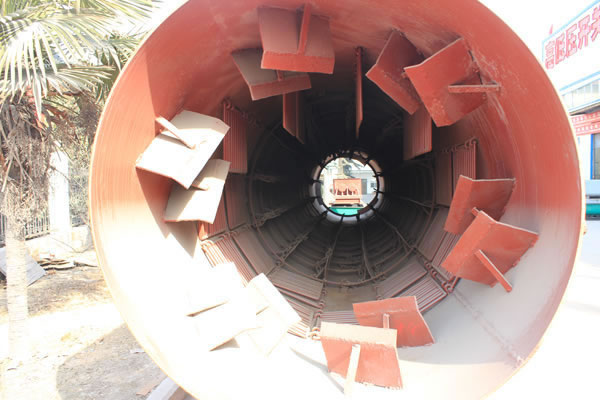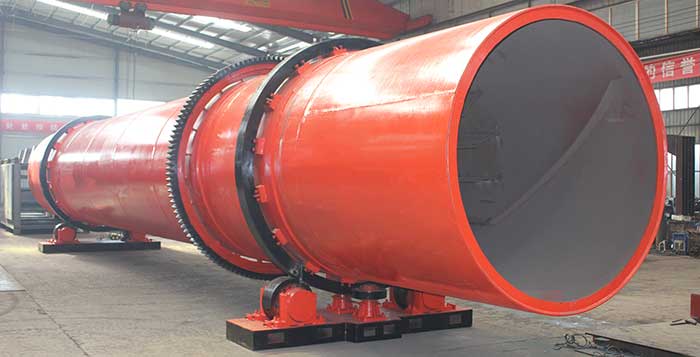
Rotary drum dryer, which is also known as rotary dryer, limestone dryer or cement rotating dryer, is the key equipment to dry different materials with humidity or granularity in various fields. According to its shape, it is also called drum dryer. China is one of the major countries to manufacture such dryer machines, and therefore, China dryer is the best-selling product in the world.
Working principle
Wet material from the belt conveyor or bucket elevator to the hopper, and then by hopper through charging pipe into the feed side. Drier with the horizontal cylinder is a slightly into tilted rotating cylinder. Material from high end to join, heat body by low-end enter, with material into counter-current contact, also have heat body and materials together and flow into the barrel. With the cylinder rotate by gravity materials to a run on the bottom of the end. Wet materials in the cylinder body forward movement process, directly or indirectly got heat body heat, make wet materials to dry, then the discharge end by the belt conveyor or screw conveyor sent. In the cylinder body wall with copy plate, it is the function of the material copied up and planted, make the material and the airflow contact surface increases to improve the drying rate and to promote material progress. Heat-carrier is generally divided into hot air and flue gas. After the heat-carrier by the dryer, generally need the cyclone to trap the material of the gas down. Through the bag filter or wet dust collector and then put emissions, if you want to reduce dust content of exhaust gas.
Application
Rotary dryer is widely applied in biomass fuels industry, animal feed industry, organic fertilizer industry, mining, building materials, chemistry and other industries, mainly stoving wood, mineral powder, slag, clay, limestone, lignite and other materials.
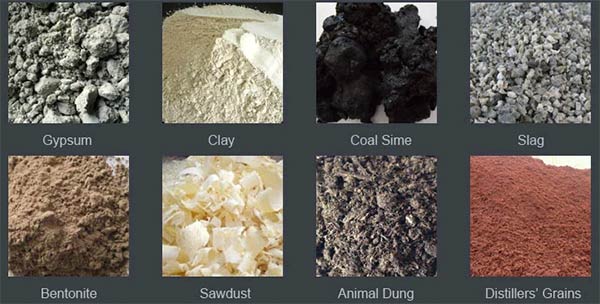
Features
- High mechanization, big capability and continuous operation
- Excellent and simple structure, steady operating process under resistance of the drum, easy operation
- Little malfunction, low maintenance cost and power consumption
- Wide application range and good drying effect
Advantage
- Specially designed lifting flights to maximize heat transfer between the material and hot gas stream.
- Heavy duty design and construction for many years of service.
- Process and Mechanical Warranties.
Rotary drying line
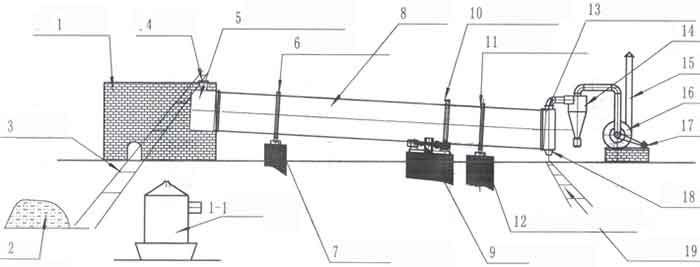
1-1. Gas Stove
2. Materials
3. Feeding Conveyor
4. Inlet
6. Roller Ring
7. Carrier Roller
8. Drum
9. Transmission
11. Roller Ring
12. Carrier Roller
13. Discharge Cover
14. Dust Collector
16. Induced Draft Fan
17. Motor
18. Outlet
19. Discharging Conveyor
How it works
The material is fed in the rotary drum dryer by the conveyor, and when it’s coming through the cylinder, the hot air will flow from it and makes it dried,. The dried material will be collected at the output.
In this drying process, the material will move as the cylinder rotation. With the gravity, the material will fall from high-end to low-end. There are also copy boards in the dryer to raise the material, so that the material and hot air’s contact surface area increases, which helps to increase the drying rate and let the material forward.
After drying, the fine particles are collected by the dust collector and the exhaust gas is discharged by the dust collector.
Details show
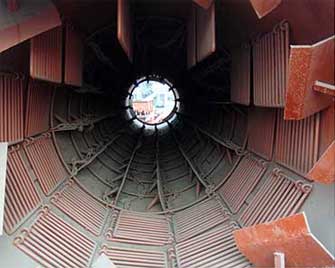 inside
inside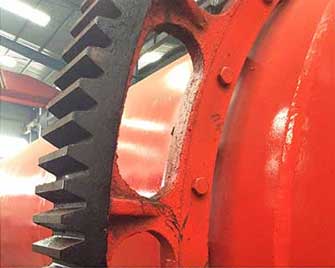 drum
drum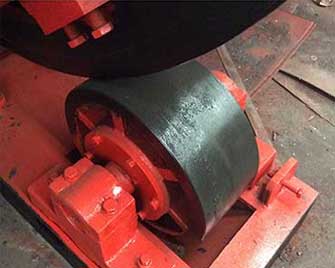 riding wheel
riding wheel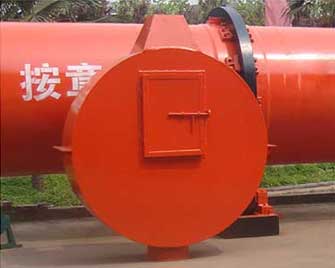 cover plate
cover plateHeat Source
gas, diesel, coal, wood, steam, etc.
Drying way
- Parallel flow: The wettest material comes in contact with the hottest gas as they enter the dryer. This results in a rapid evaporation and rapid cooling of the hot process gas. This typically allows the dryer shell to operate slightly cooler than the counter-flow configuration, which extends the life cycle and decreases maintenance of the dryer.
Features for parallel flow:
1. At the input area, the hot air is much higher than the raw material which leads a rapid heat exchange between the hot air and the raw material, moisture becomes easy to evaporate. This heat way is suitable for high moisture materials.
2. For the viscous materials, when it feeds into the dryer, as the rapid water evaporates, the moisture down and helps to reduce the bonding rate, the easier-move material increase the drying efficiency.
3. The low negative pressure in the feeding place leads to low air leakage from the input, thus keeps the hot air in the dryer steadier with the temperature and the velocity.
- Counterflow: Wet material is introduced into the drum on the opposite end that the hot gas enters the dryer and dry material discharges on the opposite end of the dryer as the exhaust vapour.
Features for counter flow:
1. Suitable for material with low moisture and low heat sensitive.
2. The drying rate is evenly distributed. So counter flow is more suitable for material which is strict with the final moisture.
3. Low dust. As the heating air move from the dry end to the wet end, as the function of the wet air, there will be less dust in the exhaust.
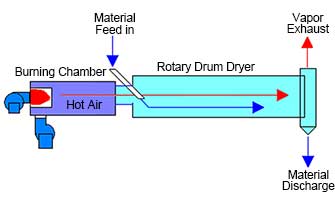 cocurrent dryer (Parallel flow)
cocurrent dryer (Parallel flow)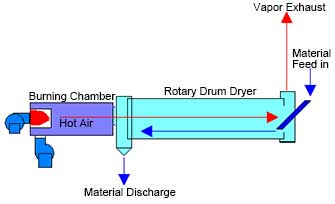 counter current dryer (Counter flow)
counter current dryer (Counter flow)Note: The heating way depends on the requirement of the final product.
Features for rotary drum dryer
Compare to other drying machines, the rotary dryer has advantages as follow:
1. With high capacity, continuous production;
2. Simple structure, easy on operating;
3. Low failure rate, low cost of maintenance.
4. The wide range of adaptation, it can be used to dry varies of material even with high adhesion;
5. Flexible operation. The quality of final product won’t be much changed when the capacity changes.
6. Easy to clean.
Parameter
| Model | Gradient (%) | Diameter (mm) | Length (mm) | Speed (rpm) | Power (kw) | Capacity (t/h) | Weight (t) |
| YK0606 | 3-5 | 600 | 6000 | 3-8 | 3 | 0.5-1.5 | 2.9 |
| YK0608 | 3-5 | 600 | 8000 | 3-8 | 4 | 0.6-1.2 | 3.1 |
| YK0808 | 3-5 | 800 | 8000 | 3-8 | 4 | 0.8-2.0 | 3.5 |
| YK0810 | 3-5 | 1000 | 8000 | 3-8 | 4 | 0.8-2.5 | 5.6 |
| YK1010 | 3-5 | 1000 | 10000 | 3-8 | 5.5 | 1.0-3.5 | 6.7 |
| YK1012 | 3-5 | 1000 | 12000 | 3-8 | 5.5 | 1.5-3.5 | 7.2 |
| YK1208 | 3-5 | 1200 | 8000 | 3-8 | 7.5 | 2-4 | 8.8 |
| YK1210 | 3-5 | 1200 | 10000 | 3-8 | 7.5 | 1.8-5 | 9.8 |
| YK1212 | 3-5 | 1200 | 12000 | 3-8 | 11 | 2-6 | 10.5 |
| YK1512 | 3-5 | 1500 | 12000 | 2-6 | 15 | 3.5-9 | 13.5 |
| YK1514 | 3-5 | 1500 | 14000 | 2-6 | 15 | 4-11 | 15.4 |
| YK1812 | 3-5 | 1800 | 12000 | 2-6 | 18.5 | 5-12 | 18.9 |
| YK1814 | 3-5 | 1800 | 14000 | 2-6 | 18.5 | 5-15 | 23.2 |
| YK1820 | 3-5 | 1800 | 20000 | 2-6 | 22 | 8-20 | 26.1 |
| YK2018 | 3-5 | 2000 | 18000 | 2-6 | 30 | 8-23 | 36.5 |
| YK2020 | 3-5 | 2000 | 20000 | 2-6 | 37 | 10-24 | 38.8 |
| YK2218 | 3-5 | 2200 | 18000 | 1.5-6 | 37 | 10-25 | 42.3 |
| YK2220 | 3-5 | 2200 | 20000 | 1.5-6 | 37 | 12-28 | 45.2 |
| YK2420 | 3-5 | 2400 | 20000 | 1.5-5 | 45 | 18-30 | 50.7 |
| YK2820 | 3-5 | 2800 | 20000 | 1.5-5 | 55 | 20-35 | 60.4 |
| YK2824 | 3-5 | 2800 | 24000 | 1.5-5 | 75 | 25-35 | 70.4 |
| YK3020 | 3-5 | 3000 | 20000 | 1.5-5 | 75 | 25-40 | 78.2 |
| YK3025 | 3-5 | 3000 | 25000 | 1.5-5 | 75 | 30-45 | 104.9 |

